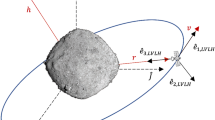Abstract
A new bi-quintic latitude/longitude spline is developed and applied to the problem of Lunar surface modeling. The new spline provides a singularity-free parameterized function over an oblate spheroid. The bi-quintic spline uses 9 parameters at each of its regular latitude/longitude nodes. At the two poles there are only 6 parameters. The resulting function is continuous and has continuous first and second partial derivatives. Latitude and longitude partial derivatives go to zero at the poles in ways that guarantee continuous first and second partial derivatives of the function when evaluated with respect to Cartesian coordinates as its underlying inputs. The new spline model has been applied to the problem of navigating a Lunar lander. The lander measures slant-ranges to points on the Lunar surface. Its navigation filter uses a model of how the slant-ranges vary with its location and orientation. This model is based on a bi-quintic spline of the Lunar surface, and it returns slant-ranges and their first partial derivatives with respect to spacecraft position and sensor line-of-sight direction. The new sensor model works well in truth-model simulation tests of the navigation filter.











Similar content being viewed by others
References
Booker, H.: Fitting of multi-region ionospheric profiles of electron density by a single analytic function of height. J. Atmos. Terr. Phys. 39(5), 619–623 (1977)
Chapman, S.: The absorption and dissociative or ionizing effect of monochromatic radiation in an atmosphere on a rotating earth. Proc. Phys. Soc. 43, 26–45 (1931)
Gill, P., Murray, W., Wright, M.: Practical Optimization. Academic Press, New York (1981)
Gross, M, Staniforth, A: Cubic-spline interpolation on a non-uniform latitude-longitude grid: achieving cross- and circum-polar continuity. Atmos. Sci. Lett. 11, 229–238 (2010)
Hinks, J, Psiaki, M: Simultaneous orbit and atmospheric density estimation for a satellite constellation. In: Proceedings of the AIAA/AAS Astrodynamics Specialist Conference, AIAA Paper No. 2010-8258, AIAA (2010)
Hofmann-Wellenhof, B, Lichtenegger, H, Collins, J: Global Positioning System: Theory and Practice, 4th edn. Springer, New York (1997)
Langel, R: The main field. In: Jacobs, J (ed.) Geomagnetism, pp 249–512. Academic Press, New York (1987)
Lundberg, J, Schutz, B: Recursion formulas for Legendre functions for use with nonsingular geopotential models. J. Guid. Control. Dyn. 11(1), 31–38 (1988)
Makar, P, Karpik, S: Basis-spline interpolation on the sphere: Applications to semi-Lagrangian advection. Mon. Weather. Rev. 124(1), 182–199 (1996)
McCabe, J, Brown, A, DeMars, K, Carson, J. III: Comparison of factorization-based filtering for landing navigation. In: Proceedings of the AIAA Guidance, Navigation, and Control Conference, AIAA Paper No. 2017-1498. AIAA (2017)
National Imagery and Mapping Agency: World geodetic system 1984 (WGS 84): Its definition and relationships with local geodetic systems. Tech. Rep. TR8350.2 3rd Ed. Department of Defense, Bethesda, MD (2000)
Neumann, G: Lunar orbiter laser altimeter raw data set, LRO-L-LOLA-4-GDR-V1.0. http://pds-geosciences.wustl.edu/lro/, accessed April 2018 (2010)
Psiaki, M: Ionosphere ray-tracing of RF signals and solution sensitivities to model parameters. In: Proceedings of the ION GNSS+ 2016, ION, Portland, OR, pp 691–705 (2016)
Psiaki, M, Bust, G, Mitchell, C: Nonlinear estimation to assimilate GPS TEC data into a regional ionosphere model. In: Proceedings of the ION GNSS+ 2015, ION, Tampa, FL, pp. 3497–3510 (2015)
Smith, D E, et al.: The Lunar Orbiter Laser Altimeter Investigation on the Lunar Reconnaissance Orbiter Mission. Space Sci. Rev. 150, 209–241 (2010)
Wahba, G: Spline Interpolation and Smoothing on the Sphere. SIAM J. Sci. Stat. Comput. 2(1), 5–16 (1981)
Ward, K, DeMars, K: Including topographical effects in slant-range modeling. In: Proceedings of the AIAA Guidance, Navigation, and Control Conference, AIAA Paper No. 2018–1333. AIAA (2018)
Acknowledgements
Mark Psiaki’s work on this project has been supported in part by the National Research Council through a Senior Research Associate appointment at the Air Force Research Lab Space Vehicles Directorate, Kirtland AFB, Albuquerque, NM.
Kari Ward’s and Kyle DeMars’ work on this project has been supported in part by a NASA grant (NNX16AF11A).
Author information
Authors and Affiliations
Corresponding author
Ethics declarations
Conflict of interests
On behalf of all authors, the corresponding author states that there is no conflict of interest.
Additional information
Publisher’s Note
Springer Nature remains neutral with regard to jurisdictional claims in published maps and institutional affiliations.
Rights and permissions
About this article
Cite this article
Psiaki, M.L., Ward, K.C. & DeMars, K.J. A Bi-quintic Latitude/Longitude Spline and Lunar Surface Modeling for Spacecraft Navigation. J Astronaut Sci 67, 657–703 (2020). https://doi.org/10.1007/s40295-019-00192-1
Published:
Issue Date:
DOI: https://doi.org/10.1007/s40295-019-00192-1




